Why Policy Change is the Only Way to Open Impact Investing Floodgates
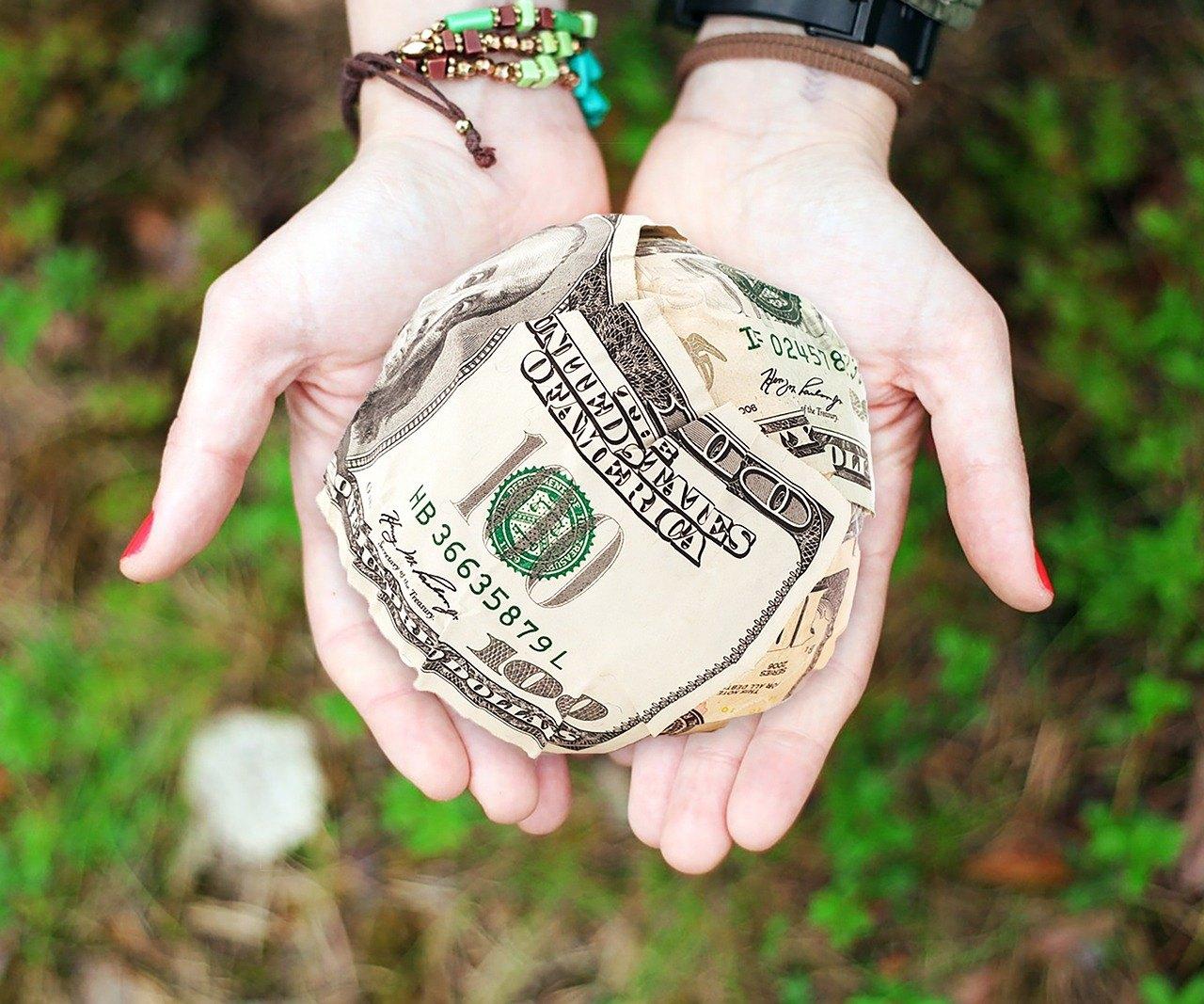

By Beth Sirull and Brenna McCallick
What’s standing in the way of impact investing exploding in the United States? We are seeing lots of intention. Everywhere we turn, we hear more and more from investors who are excited about impact investing. Bain Capital and Blackrock have created dedicated impact practices. High net-worth individuals and family offices are starting to gather on a dedicated platform, ImPact, to share deals, ideas and experiences. Foundations are sharing best practices and forging ahead on Mission Investors Exchange. Even pension funds are making some Economically Targeted Investments (ETIs) to earn appropriate financial returns and create economic opportunities in low-income areas.
And yet, the amount of dollars invested in real projects and actual businesses is still a minuscule percentage of all invested capital. What’s holding us back?
While changes in public policy won’t automatically open up floodgates of impact capital, creating a policy ecosystem that allows — and encourages — impact investing, is a necessary, but insufficient, condition. Changes in policy are arguably step one. Let’s look at an example:
- ERISA. In 2008, the Department of Labor (DOL) issued an interpretive bulletin on the Employee Retirement Income Security Act, or ERISA, which sets the standards of fiduciary duty for pension funds. The bulletin established what is known as the “rigid rule,” a mandate that pension fund managers invest solely with a view to maximize returns for their beneficiaries, and prohibiting the consideration of other factors, such as environmental, social or governance (ESG) issues, in investment decisions. The rule has since been seen to have a “chilling effect” on ETIs made by pension funds, many of which view such investments as too risky or in violation of fiduciary duty.
Retracting the rigid rule would open the door for pension funds to invest for social and environmental impact alongside ― and not at the expense of ― competitive returns for their beneficiaries. This would constitute big win for impact investing, and not only because pension funds represent over $22 trillion in total assets in the U.S. alone. While ERISA technically only applies to private pension funds, it effectively sets the standards of investment for other large fiduciaries, and any changes to the policy have the potential to create a ripple effect beyond those it directly governs.
These changes are necessary, although we are not likely to see a change in investing the day after they’re made. But once these changes are realized, we can move to step two: reaching out to pension fund managers and their advisors, as well as the lawyers, accountants and investment managers that advise the thousands of foundations in the U.S., to educate them on the availability of impact investments. This outreach will need to showcase examples of solid investments that have worked, and we will need to demonstrate that impact investments can be made effectively and efficiently. But the culture shift we need will not be achieved without the catalyzing power of policy change.
With the importance of these policy changes — and others — in mind, Pacific Community Ventures was excited to launch the Accelerating Impact Investing Initiative (AI3) project in 2013, in partnership with the Initiative for Responsible Investment and Enterprise Community Partners, and with the support of the Ford Foundation and the Surdna Foundation. Our goal is to explore concrete, specific opportunities and strategies for enacting critical policy changes that will strengthen the impact investing ecosystem in the U.S.
Throughout 2014, we convened and consulted with stakeholders from across impact investing and community development realms, and collaborated with the U.S. National Advisory Board and the Social Impact Investing Taskforce. From these collaborations, we developed tools for making sense of the various ways the federal government can and has enabled impact investing in the U.S. ― tools to help advance meaningful policy change going forward.
The AI3 recently released a “mid-term” report, a framework for understanding and assessing policy ideas. Entitled Financing Social Innovation: Analyzing Domestic Impact Investing Policy in the United States, the report offers a brief look at historic and existing public-sector activity in support of impact investing, and provides tools for practitioners looking to navigate the complex universe of U.S. policy levers that harness private investment for public benefit.
The AI3’s work is far from done; we will continue to identify specific policies — particularly changes in guidance and regulation, rather than in legislation, understanding that Congressional gridlock can hamper such efforts — that both allow and incentivize impact investing.
We encourage you to join the conversation. Send your comments and questions to [email protected].
Image credit: Pixabay
Beth Sirull is the President of Pacific Community Ventures, a social enterprise dedicated to creating jobs and economic opportunities in low-income communities. She is a co-recipient of the James Irvine Foundation California leadership award, and has been named to Forbes’ “30 Top Social Entrepreneurs” and the San Francisco Business Times’ “Most Influential Women in Bay Area Business.” Beth holds a Masters of Business Administration from Boston University and a Masters in Public Policy from the University of California, Berkeley.
Brenna McCallick serves as Research Associate for PCV InSight, supporting PCV’s domestic and international impact investing policy initiatives. In her work with the Accelerating Impact Investing Initiative (AI3), Brenna conducts research on U.S. public policy as it relates to impact investing and produces content for AI3 publications.
Video: Monique Oxender, Keurig Green Mountain on "The ROI of Sustainability"
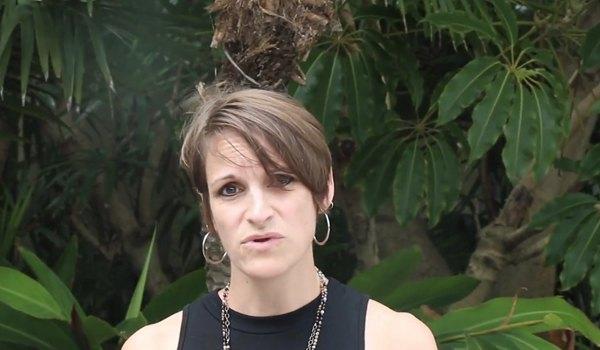

This article is part of a series on “The ROI of Sustainability,” written with the support of MeterHero. MeterHero helps companies and organizations offset their water and energy footprints through consumer engagement. To follow along with the rest of the series, click here.
At Sustainable Brands 2015, we asked thought leaders to define the ROI of Sustainability in their words. In this video, Monique Oxender of Keurig Green Mountain shares some thoughts:
https://youtu.be/5-P8-yo4UVA
About Monique Oxender: Monique Oxender leads the efforts of Keurig-Green Mountain to brew a better world. She joined the company in 2012 and has navigated a path for integrated sustainability management during the recent period of growth and change. This journey travels directly through the intersection of world benefit and business value, informed by meaningful internal and external stakeholder engagement. Prior to joining GMCR, Oxender designed and developed a leading supply chain sustainability program for Ford Motor Company.
How One Social Venture Unlocked the Code To Millennial Giving


By Sarah McKinney
Today the global population is being confronted by immeasurable social and environmental challenges. At the same time, the Internet gives everyone with a computer or smartphone unprecedented visibility to on-the-ground realities. This hasn’t just increased our awareness of what’s going on, but has also allowed us to connect on a more emotional level.
Countless nonprofits have been established to improve complicated situations, touching on issues such as human rights, climate change, education reform, disease prevention and poverty (to name a few), and the desire to donate money in support of these nonprofits is strong – particularly among millennials.
A recent study found that 87 percent of millennials gave money to a nonprofit in 2014. The “ALS Ice Bucket Challenge” campaign raised well over $100 million dollars for a single nonprofit last year, and millennials played a big part in its success. But for most nonprofits, standing out from the crowd and securing continued financial support from millennials has never been harder. And leveraging technology in a way that resonates with them has never been more important.
This is the problem that Taylor Conroy, the founder and CEO of Change Heroes, is focused on solving. After returning from a trip to Africa in 2009, where he visited a number of different villages and was able to see a library come to life as a direct result of the donation he made to the nonprofit Free the Children, he became determined to uncover what motivates his millennial peers to deepen their engagement in philanthropic giving.
He spent several months conducting creative experiments and in-depth interviews, and uncovered five key drivers:
1. Group mentality: They were more apt to give when doing it as part of a group.
2. Tangible outcomes: They wanted to see visual proof of their impact.
3. Micro giving: It was easier to part with small amounts daily than one lump sum.
4. Personal connection: The relationship between the fundraiser and donor was key.
5. Recognition: It mattered to them, and it inspires continued engagement.
He launched Change Heroes in 2011 with a business model based on these findings. Unlike other donation platforms, Change Heroes began with a very singular focus – asking “campaign runners” to rally 33 of their friends to give $3.33 every day for 3 months and raise $10,000 to build a school or library in Africa.
Free the Children was established as the platform's first implementation partner, and Change Heroes retains 6 to 10 percent of all funds raised – generating revenue needed to cover operational expenses and scale growth.
Particularly unique to Change Heroes is its personalized video invites that campaign runners can choose to send out to each potential donor – an intuitive task for a generation that uses Snapchat, Vine and FaceTime to communicate with friends. Those who take advantage of personalized videos are 80 percent more likely to reach their funding goal (than those who send the same video to everyone), and 50 percent of the people who receive a personalized video invite end up making a donation.
While the specific amounts can now vary (i.e., the daily donation, number of people giving, days the campaign is running, and total fundraising goal), the basic formula for Change Heroes has remained the same – and it’s working. To date, Change Heroes users have given $2.1 million dollars through 555 campaigns funding 210 projects, and positively impacting 210,000 children in 15 developing countries. The average donation is $246, and the average campaign raises $5,000. The company has an online dashboard that reports many of these statistics in real time, along with a Top 25 Change Heroes leaderboard, where full names are listed next to total donation amounts. But that’s just its consumer offering.
At the end of 2014, Change Heroes raised a seed round of investment and launched a white label B2B product that is revolutionizing the way charities, nonprofits and socially responsible corporations tap into millennial giving. The software allows any organization to create a custom campaign so they can better diversify their funding portfolio, and decrease reliance on large-scale yearly donations from major sources. And because the Change Heroes model of giving is so popular with millennials, organizations are expanding the age range of their donor base while giving young people a fun and easy way to pool their friends and rally support for outcomes they believe in, and perhaps didn’t know how to support in the past.
This generational transition, from relying predominantly on baby boomer donations to developing transactional relationships with millennials that are based on transparency and trust, is important to the sustainability of every single charity and nonprofit organization in the world.
One example of a for-profit company using Change Heroes’ software is Royal Bank of Canada Insurance (RBCI). The company wanted to do more for its charitable partner, and supporting economic empowerment initiatives was aligned with its corporate social responsibility (CSR) goals.
So, the bank worked closely with Change Heroes to create a custom campaign asking individuals to rally their friends and raise $3,000 to provide a community of mothers in Ecuador with much-needed education, business skills training and support. RBCI used social media and its existing network to spread the word. By the end of the first month, 66 campaigns were launched and $94,000 was raised – far exceeding the company’s expectations.
Other clients to date include Disney, Morgan Stanley, United Nations Foundation and Safe Horizon’s Streetwork Project, a youth and teen homelessness program formed in 1984 in response to the growing number of homeless teens in New York City.
Change Heroes works with each organization to ensure their campaign isn’t just brand-aligned, but also successfully tells the story the companies want conveyed through optimizing design, copy and video campaign components. This kind of heavy hand-holding is important, as the employees working to drive social and environmental progress from within organizations are often being pulled in a million directions. And Change Heroes wants to make sure they don’t miss out on meeting millennials where they are, in what is quickly becoming a global movement of online giving.
Image credit: Change Heroes
Sarah McKinney is a freelance writer and consultant with over a decade of experience in market research and an MBA in sustainable management. Follow her @sarahmck
Walmart's New Fees Have Worrisome Sustainability Implications

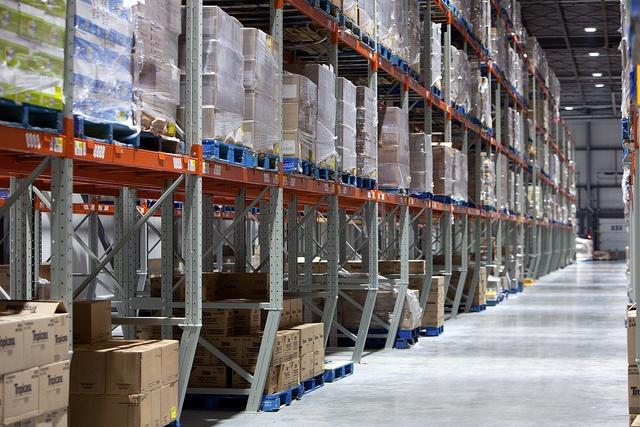
By Marc de Sousa Shields
Walmart recently announced it will require all suppliers to pay warehousing and shelf-stocking fees. The new policy, the company says, brings consistency to supplier treatment as some vendors had been charged in the past, whereas others had not.
The retail giant claims the changes are aimed at working with suppliers to serve "shared customers" and achieve the low prices "they expect and deserve."
There are at least three worrisome sustainability implications raised by these fees, which are symptomatic of emerging retail and distribution trends not unique to Walmart.
The lines between retail and distribution are blurring
Not so long ago, when we wanted to buy something we either had to go a store or order it from the anxiously awaited Sears catalog. Then along came Amazon et al, and we thought the end of brick-and-mortar retail was nigh.
It wasn’t, and online selling is now just one more way to get the things we want.
Walmart’s move to charge fees, in fact, is simply another salvo in the youthful “omni channel” retailing and distribution era, where everything is available everywhere pretty much instantly. If the deep fryer you found on sale at Walmart while visiting Aunt Tina in Peoria is out of stock, you simply take out your smartphone, pay online and order a pick-up at your local store in Springfield for when you get home.
Simple on the surface, omni channeling is complex, requiring great scale and sophistication to manage. But it has also created new opportunities, particularly for selling spare warehouse space and distribution capacity.
An example: Your sister is in a small store in Portland. She takes a picture of a purse she thinks you might like and sends it to you. You love it, and order it online from the store, which, when it receives your text, sends a note to Amazon that, in turn, locates the purse at a JC Penny in Flagstaff, Arizona, that ships it via Fed Ex to your home in Chicago. At each transaction point a storage and delivery fee is paid.
Walmart’s new fees simply reflect the trends underlying the fast blurring lines between retail and distribution, where in-store shelving, warehouse space, stock management and delivery capacity are not just means to a sale but income-generating assets in their own right.
Of course, not all of this is all that new either.
Shelf space/stocking fees, also known as slotting, has been going on formally and informally for years. While many suppliers complain it gives unfair advantage to larger companies, retailers claim it helps to allocate shelf space for sales maximization. It can also act as a hedge against new product failure (given that over 20,000 new products compete annually with 50,000 established products, this risk is real, especially as 90 percent of new products are withdrawn every year).
How much do stores make selling space? No one knows for certain, but some estimates are as high as $18 billion a year. Indeed, retailers can earn more from carrying some products than from actually selling them.
Three sustainability issues
From a sustainability perspective, there are three worrisome considerations.
First: Are universal slotting and warehousing fees just another way for Walmart to take margin at the expense of suppliers?
It’s hard to say. But if you’ve been a Walmart vendor (as one of my companies nearly was), you know the great and continuous pressure to provide ever lower prices, often with a host of equally challenging delivery conditions.
Many venders have already cut costs to the bone, so it’s not hard to imagine how this new squeeze might tempt suppliers, particularly in lax jurisdictions, to externalize labor, environmental and social costs more than they already might do. A recent Harvard study showed an ironic and demonstrative sustainability impact of pushing costs down the chain when it found suppliers paying for their own social audits had more undisclosed violations than those paid for by retailers.
Meanwhile, other studies have shown slotting, and by inference selling warehouse space, is done at the vendors’ expense, adding only to the retailer’s bottom line with few savings being passed on to “deserving” consumers.
Second, as noted, slotting is thought to create an unfair barrier to small business, who without the cash to compete with large companies can’t get shelf space. The U.S. Federal Trade Commission is agnostic about this, saying there’s no evidence that slotting results in anti-competitive advantages or unduly affects consumer interests. Still, in some countries such as Poland, slotting fees are illegal and others, such as China see periodic crack-downs on the practice.
Small, nimble firms may have an advantage early on in the emerging omni channel economy, but as systems mature toward greater scale and slimmer margins, larger players will naturally dominate. It is not inconceivable that smaller vendors may soon face the same competitive pressure Walmart was said to have had on local shop owners in the 1990s.
Third and most challenging, if sustainability is truly about consuming less, the world hardly “deserves” low prices on much of the stuff it sells – stuff, not incidentally, all produced by the lowest bidder.
Where to now?
New sales and distribution channels are rapidly evolving, and it’s not entirely clear how small companies and sustainability will be affected over the long term.
In the meantime, downward price pressure on suppliers will have fairly predictable outcomes on supply chain sustainability aspirations and not necessarily to the benefit of consumers.
Image credit: Flickr/Walmart
Marc de Sousa Shields is Managing Director at ES Global a corporate sustainability advisory based in Mexico. Marc has worked in over 40 developed and developing countries, focusing on corporate sustainability strategy, brand, and returns. He is author of the soon to be released Sustainable Century by Design or Disaster and host of the Sustainable Century Podcast Series. See www.thesustainablecentury.net www.csrcounts or www.esglobal.com
The Tremendous Economic Loss in Old Office Furniture
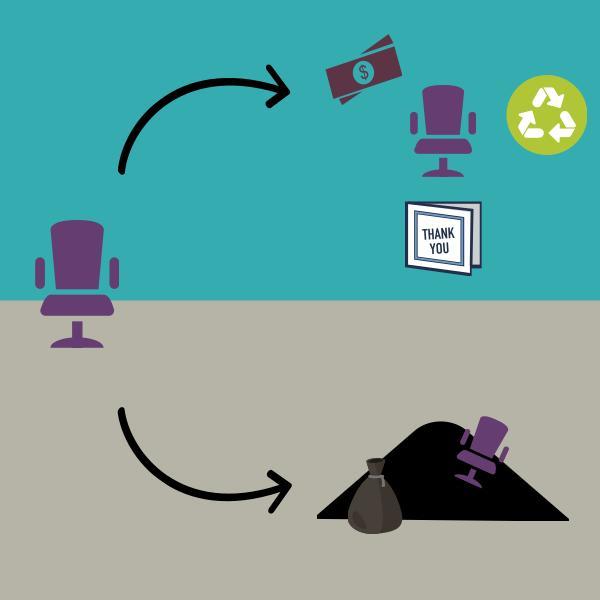

By Nicholas Buccheri
It’s difficult to imagine why office furniture matters outside the office. Until you see a thousand-line spreadsheet of items destined for the landfill, there’s little to connect your sleek new executive chair – or anything else in your office, for that matter – to an ongoing environmental and social issue.
Those in corporate real estate and facility management know well that large organizations continually shuffle people around, renovating and moving offices and discarding older furniture, equipment and supplies in the process. The real eye-opener is how much of this furniture makes its way to the dump – somewhere in the millions of tons annually in the United States and Canada. (It’s actually so poorly monitored that there is little data to go by).
It shouldn’t be as easy as it is today to ignore hundreds of thousands of tractor trailers filled with usable furniture and supplies, if not more, traveling to the dump each year. If we’re ever to effectively control the greenhouse gas emissions, harmful leachates and habitat destruction associated with landfills, practices like this have to end.
Then there’s the tremendous economic loss. In the process of dumping usable goods, billions of dollars in recoverable natural and synthetic resources are lost. It’s a huge amount of economic activity to short circuit -- and well before these products even come close to the end of their lifecycle.
And while the issue isn’t likely to make the sustainability headlines with the likes of climate change or global water scarcities, its solution isn’t nearly as complex either. There is little more than a lack of imagination, experience and planning preventing organizations from effectively repurposing and recycling no-longer-needed assets.
Part of the problem is that clearing out an office seems straightforward. Until you’re staring down the barrel of that thousand-line spreadsheet, it seems plausible, maybe even likely, that everything can be resold or donated easily. After all, businesses invest a lot into their office equipment and naturally assume it can be resold for a comparable amount.
By the time decision-makers realize that the second-hand furniture market is limited and that large-scale donation is itself a complex project, they’ve wasted too much time to implement an effective solution. They’re left with no real plan and a dwindling timeline. At the risk of delaying other components of a broader workplace project, they turn to the only option that requires neither time nor strategy: a liquidator (or worse, a junk-removal service).
In either case, a majority of the items are landfilled. Liquidators tend to sell the most valuable items and dump the remaining inventory by the ton. Junk-haulers will sell various pieces for scrap returns and landfill the rest. The result is garbage — literally and figuratively. These solutions achieve little-to-nothing and virtually guarantee that usable products and materials will be wasted. Hence the millions of tons of waste produced each year.
Turning an environmental risk into a social opportunity
To solve the problem, two main things have to change. First, organizations have to take seriously the way they manage surplus office furniture. As long as it is an afterthought to a broader workplace project, usable products will continue to be haphazardly discarded.
Second, the commercial sector needs to recognize the risks and opportunities that come with managing commercial equipment – more specifically, how to turn the environmental risk into a social opportunity. A higher standard of planning and integration can recover measurable value where there is typically only a loss.
In-kind donation, for instance, is cost-effective, and environmentally and socially beneficial when properly executed. It removes the hard costs of landfill and provides nonprofit organizations – some of which go decades without updating their office interiors – the opportunity to improve productivity, employee satisfaction and even safety. It can also free up budget for core programs and activities. Plus, it’s a novel, cost-effective way for corporations to engage with community organizations and nurture community partnerships.
Combined with resale and recycling, it becomes a powerful triple-bottom-line tool for businesses.
But it requires decision-makers to reevaluate their used office assets and start planning early. This means working with multiple departments to capture value -- from those on the ground floor, like facilities teams, to those who care most about the outcome like sustainability and communications teams. It means tracking the landfill diversion rates and community impact across all office projects to benchmark performance and work toward improvement. And it means changing procurement practices and vendor relationships to better close the loop on office waste over time.
It strikes me that the way businesses currently manage and dispose of used office furniture serves as another gut-wrenching example of just how wasteful we can be, even with corporate sustainability and social responsibility entering the business mainstream.
Office equipment makes a difference, not only in the way we use it (as in completely and utterly depend on it in nearly every aspect of business), but also in the way we treat it at the end of its life. And, as we’re seeing across the board with waste, energy and water, amazing things can happen once you challenge the complacency of an industry -- things that directly help businesses, the communities in which they work and the greater environment.
That office furniture has impact isn’t up for debate. The only question is: What are businesses doing to make sure its a good one?
Nicholas Buccheri is the marketing and communications manager at Green Standards, a specialized sustainability firm that helps corporations manage their office assets responsibly, and a freelance communications consultant to mission-driven organizations and businesses.
Tackling climate change can boost UK plc, says report


A new report from business leaders alliance, the Aldersgate Group, shows that tackling climate change can provide significant economic opportunities for the UK and make its economy far more competitive and resilient to shocks in the future.
The report, A Brighter, More Secure Future: Low carbon priorities for the new government, gathers contributions from leaders drawn from sectors as varied as the telecoms, manufacturing, finance, retail, construction, cement, energy and engineering consultancy industries as well as prominent academics, consumer groups and NGOs.
Nick Molho, executive director of the Aldersgate Group said: “The recommendations that business, academic and civil society leaders have set out in this report will help the UK meet its emission targets on time, on budget and in a way that’s economically beneficial. We urge the government to take note of them and put forward stable policies for the decade ahead.”
Responding to the report, Energy and Climate Change Secretary Amber Rudd said: “This report shows the scale of the economic opportunity around low-carbon growth. A technological revolution is already underway and the UK is powering ahead with innovation, enterprise and competition.
“We will push for an ambitious deal in Paris that helps create confidence and a level playing field for business to thrive while helping to combat climate change.”
MGM Resorts: Inclusive Training Programs are the Key to Great Leaders
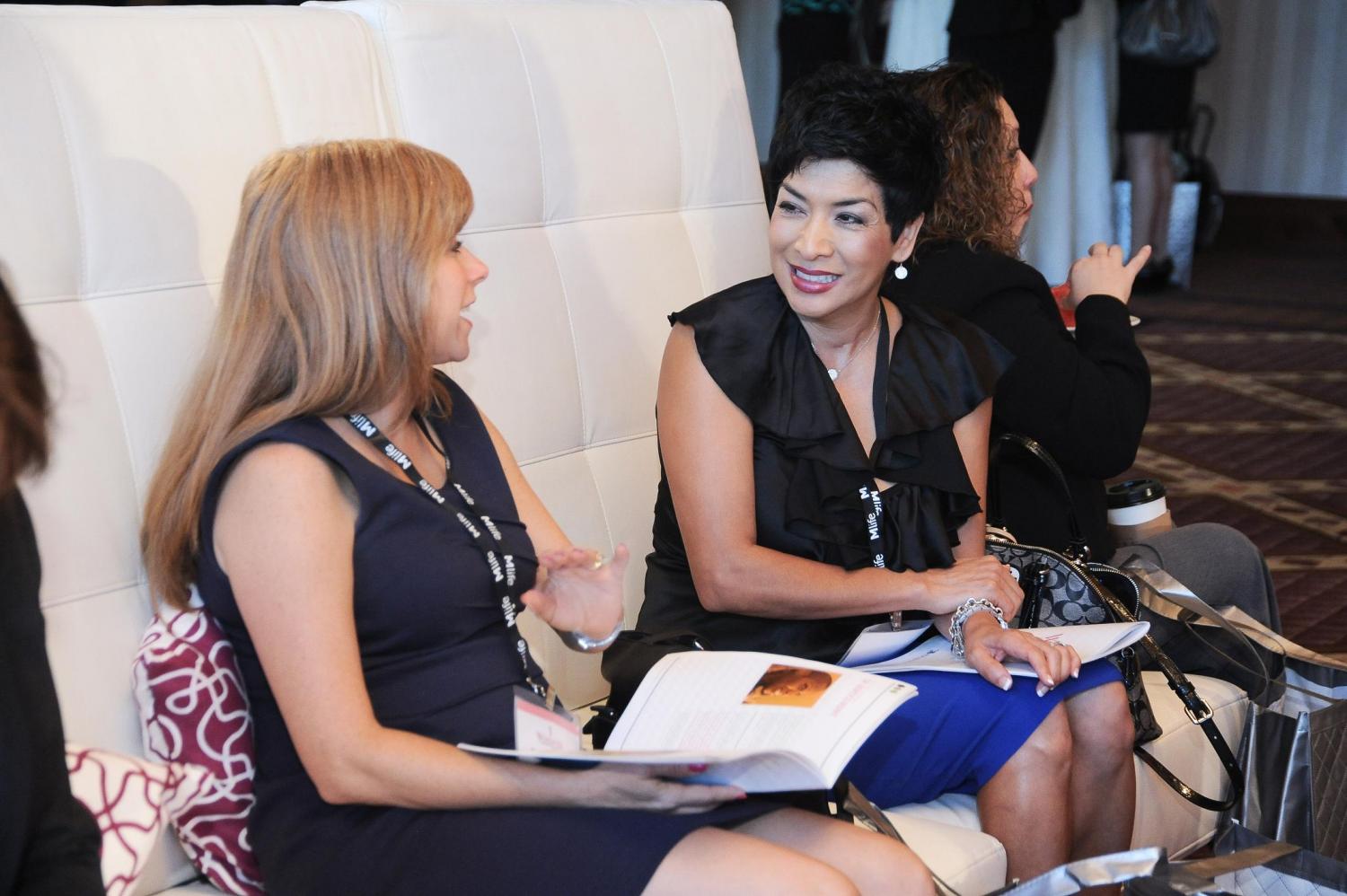

Gender diversity is an increasingly common topic of discussion for U.S. businesses these days. Until recently, much of that national discussion has centered around what isn't working and why it doesn’t work: the types of jobs that don’t offer equitable pay opportunities for women; the lag in corporate on-the-job training or career advancement for women that has plagued some business sectors; or the challenges that women face in trying to break the glass ceiling.
One corporation that is helping to dramatically change the tempo of that dialogue is MGM Resorts International, the parent corporation to Las Vegas casinos such as the Luxor, New York, New York, Excalibur and MGM Grand. It has received numerous accolades in recent years for the innovative employee diversity programs run on all of its 15 properties in Nevada, Michigan and Mississippi.
In 2012 the company launched its Inspiring Our World production, a 90-minute musical on the value of diversity, presented exclusively for its 62,000 employees. The fact that the concept was pioneered and led by employees, and was enjoyable and engaging, helped to drive home its essential message: Diversity of thought is an important element in creating a cohesive, creative corporate culture. The 70 employee-performers not only talked to their audience about diversity, but they also shared their life stories, their challenges, and their dreams for being accepted and successful members of the company.
The musical helped deliver the message that diversity is not only okay but broadly supported at MGM Resorts. Its leadership, recruitment programs and mentorship programs, which range from summer internships to robust, year-long upper management programs, reinforce that message even further by providing structured advancement opportunities for all staff, irrespective of gender, identity or ethnic background.
To get a sense of how MGM Resorts addresses diversity and women’s leadership opportunities, we talked to Michelle DiTondo, senior vice president of human resources for MGM Resorts. DiTondo’s team came up with the concept for Inspiring Our World as a means of teaching its 62,000 employees the importance of a cohesive and inclusive corporate culture.
Diversity starts with an inclusive recruitment process
“We have a lot of focus on pipeline programs: bringing leadership into the company in conjunction with our recruitment program, and developing new leaders,” DiTondo told TriplePundit. The company also tailors its pipeline programs to meet the attributes best represented by the applicants they recruit.
A key example of its pipeline programs, said DiTondo, is the Management Associate Program (MAP), a 12-month program geared to recent college graduates that provides new hires with on-the-job training and exposure to a variety of jobs in their area of interest.
Participants also receive leadership training and mentorship in a cohort setting, where they are encouraged to establish connections with other employees. “The reason we do that is so they get to know one another,” DiTondo said. Forming teams that are supportive and inclusive is an important element of MGM Resorts' leadership training strategy, she told us.
“We have a number of our senior leaders who entered the company through MAP," said DiTondo, who noted that the program has been operating for more than 20 years.
The company also runs a Hospitality Internship Program (HIP) which it staffs through yearly recruitment at universities across the country. Hirees attend a 12-week program that gives them wide exposure to the industry, the company's structure and on-the-job training. As in the MAP, employees have the opportunity to network through regularly scheduled meetings, tours and training.
MGM Resorts' more unusual pipeline program is Boots to Business, which is open to both external applicants and MGM employees who have served in the military.
“The idea behind Boots to Business is we identify veterans for their personality traits and the skills they gained in the military, like leadership, teamwork [and] discipline,” all qualities that do well in a hospitality setting. Mentorship plays an important role in this program as well.
“We have had some women veterans participate in the program,” DiTondo said. The program helps veterans reach past the standard challenges that many often face after active military service: limited work experience and insufficient on-the-job training. At the same time, it focuses on those characteristics that would be most beneficial in a hospitality setting.
Top-notch casinos and resorts in Las Vegas have their own cadre of professional chefs, and MGM Resorts properties are no exception. Keeping the busy kitchens staffed with talented chefs is essential, which is why the Culinary Associate Program (CAP) serves as an essential network for culinary staff who want to excel in their careers. MGM Resorts recruits at culinary institutes, but it also maintains an open-door policy for MGM staff who want to learn to become chefs.
Internal leadership programs nurture growth
In some companies, training programs are only open to supervisory and management level employees. MGM Resorts offers training to all levels of its staff, from hourly workers who have their eye on supervisory career, to managers who wish to further their career as directors, vice presidents or presidents of MGM properties. The Aspire and the Management Academy programs, for example, provide training for hourly employees who wish to move up the ladder, while the Management Institute is MGM Resorts’ equivalent of an MBA program.
“The intent of the Leadership Institute is to take people who are great leaders [such as front-desk supervisors and hotel directors] and give them exposure to a broader perspective of the company,” DiTondo told 3p.
The program gets a high amount of interest from women looking to move up the managerial ranks because it helps to address a common factor in the hospitality industry: According to the Bureau of Labor Statistics, 45 percent of the 1.1 million food service managers in the U.S. were women in 2014. Fifty-five percent of the 146,000 lodging managers fit within that category as well. Leadership training that allows women to break out of low- and mid-management jobs is one of the perks of working for MGM Resorts.
But that isn’t the only way that women are able to excel in their respective areas of interest. According to DiTondo, mentoring and sponsorship create powerful mechanisms for ensuring high-performing employees and managers get the training and opportunities they seek.
“In every one of our programs you will find a mentor,” said DiTondo, who added that upper management are required as part of their jobs to have one or more mentoring relationships.
“In the gaming industry, formal talent management hasn’t been a big part of how people were promoted through an organization,” DiTondo said. Up until the 1990s, a job search in Las Vegas was most successful if you knew someone in the respective company network who could vouch for qualifications. “It was largely who you know,” she said. “To change that culture and to promote people on their experience and their knowledge and competencies … we have had to put into place a number of formal development programs and tools to help us.”
Mentoring nurtures the management skills of the leadership trainee by pairing the individual with seasoned managers. It also provides a means by which corporate management can identify new talent for up-and-coming positions.
Many of those leadership promotions come through sponsorship, in which an applicant is recommended for career advancement. “Sponsorship is what comes out of mentorship,” said DiTondo, and it is a valuable tool for career-oriented hospitality managers. At MGM Resorts, approximately half of those who apply for sponsorship are women, increasing the demand at the corporate level to ensure that the opportunities at its 15 properties reflect the diversity of the applicants.
“We do work very hard in the recruitment to make sure the programs are diverse in representation,” DiTondo said.
And while MGM Resorts’ history of women leaders demonstrates that these strategies work, sponsorship in the global work sector hasn’t always been as available to women as it has been to men. The Harvard Business Review reports that, as recently as 2010, women still found it much harder to get sponsored in their line of work than men. In contrast, MGM’s sponsorship structure is available to both women and men, DiTondo said.
Employee networks reinforce inclusiveness
Perhaps one of the most powerful offshoots of the Inspiring Our World was an appreciation of employee networks. MGM Resorts has 18 employee networks that serve to connect people with similar interests, backgrounds and identities. But most valuable, said DiTondo, is the personal reinforcement and support that comes from employees knowing there are others in MGM’s expansive population that hold similar views, interests and backgrounds.
Being part of a network, and knowing that it’s okay to be who you are, gives empowerment and tells employees that they can have the courage to pursue their career goals.
MGM Resorts’ Women Leadership Conference is open to all
This July, the MGM Grand will host the company's most renowned management program, the Women’s Leadership Conference. It is MGM Resorts’ only gender-directed leadership program, and the turnout it received last July suggests that it is filling a void for women who seek more networking and more opportunities in their fields. The conference is well-attended by MGM Resorts employees (both women and men may attend), and provides another venue for women to fine-tune their leadership knowledge and skills.
And, like many of MGM Resorts’ other novel programs, it is helping to redefine leadership in the hospitality sector. With increasing studies showing that leisure and hospitality companies actually win by building diversity into their ranks, MGM Resorts’ management programs are setting a standard that improves opportunities for both companies and their future leaders.
Images courtesy of MGM Resorts
New Climate Commitments Help Set the Stage for Paris
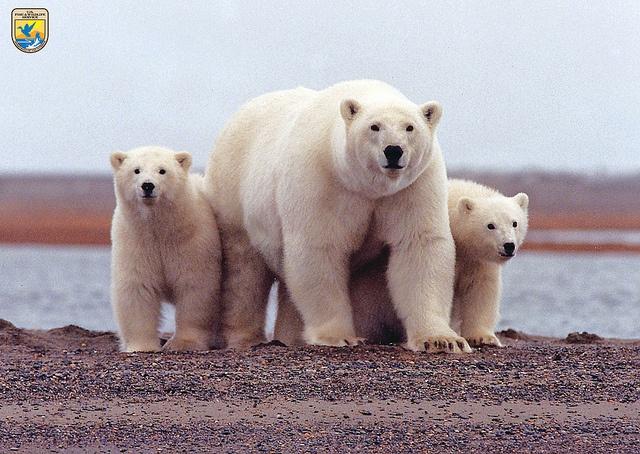

This past week has certainly been an eventful one, enough so that this important bit of news on the climate change front might have slipped by unnoticed.
Three of the top 10 carbon emitting nations -- the U.S., China and Brazil -- announced new carbon reduction commitments in a joint news briefing on June 30. The countries pledged to obtain 20 percent of their electricity from renewable sources, not including hydropower, by 2030.
Brazilian President Dilma Rousseff was in Washington for the announcement. Brazil, which is considered the seventh largest emitter (if the EU is treated as one country), further announced that they would restore over 46,000 square miles of forests, an area the size of England, while pursuing “policies aimed at eliminating illegal deforestation.”
For its part China pledged to reduce its emissions, relative to the size of its economy, by 60 to 65 percent by 2030. This adds specificity to the agreement China made with the U.S. back in November. Back then, the Chinese simply said that their emissions would peak by 2030. Their target at that time was a 40 to 45 percent reduction. So, this represents a significant uptick. Given the size of China’s economy, it’s clear to everyone, including the Chinese, that whatever they do could determine the outcome for all. China is now both the largest producer and largest customer for solar energy products.
For the U.S., this would mean tripling renewable energy output by 2030. That sounds ambitious, but given its recent rate of growth for solar alone, which is doubling every three years, it seems fully achievable. Still the U.S. will need substantial contribution from wind and other sources, including geothermal, to meet that goal. Beyond this, the U.S. will depend on new EPA regulations for both motor vehicles and power plants to meet its target.
This agreement, as the New York Times reported, adds “momentum” to the cause of addressing climate change, and positions the major powers well for a historic agreement in Paris at the end of this year.
“Following progress during my trips to China and India, this shows that the world’s major economies can begin to transcend some of the old divides and work together to confront the common challenge that we face — something that we have to work on for future generations,” President Barack Obama said of the announcement:
Christiana Figueres, executive secretary of the United Nations Framework Convention on Climate Change (UNFCCC), said, “Over the past 24 hours, we’ve seen a very nice example of the diversity of countries engaging on the climate solution.” But she added, “The sum total of these does not get us to 2 degrees.” (The U.N. Environmental Program says capping global temperature rise at 2 degrees Celsius is critical.)
What will it take to get over that hump? Well, for one thing, some major polluters, such as India and Japan (No. 4 and No. 8, respectively) have not yet submitted their plans to the U.N., as required by last year’s Conference of Parties in Lima, Peru.
But most experts are saying the Holy Grail will be a global market-based deal that establishes a price on carbon. What’s ironic about this is the fact that a) China is already doing this, and b) the U.S., where the idea first originated and who is probably the world greatest supporter of market-based solutions to everything else, is not. The reason why, of course, is the fact that many Republicans are not only refusing to do anything, but continue to even acknowledge that the problem even exists. Oklahoma Sen. James Inhofe, chairman of the Senate Environment Committee, is using his skepticism of China’s commitment as an excuse for inaction, essentially saying: "Why should we act if we don’t believe they will?" This latest commitment gives Inhofe less to stand on, not unlike the polar bears whose Arctic ice floes continue to shrink.
Another yet unresolved issue is money for the developing countries that need assistance -- not only to transform their economies, but also to adapt to the rapidly changing conditions. President Obama has already pledged $3 billion toward the Green Climate Fund, but Republicans are not willing to let him have it.
Image credit: US Fish and Wildlife Service: Flickr Creative Commons
Why Tom Steyer Should Spend $100 Million on Green Schools
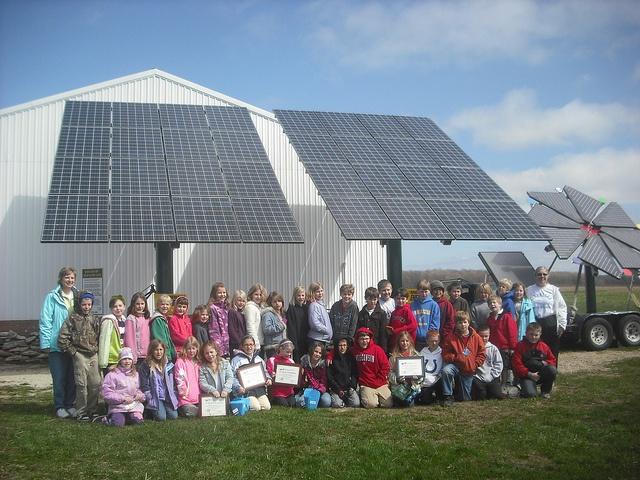

By Joseph Plummer
In the 2014 election cycle, Tom Steyer spent over $65 million of his own money on key Senate and gubernatorial campaigns. That is a lot of money, but that isn’t much compared to the money being put forth by the Koch brothers’ network. As climate activists and citizens of the human race, we want Tom Steyer and others to spend massive amounts of money to communicate climate issues to the public during election season (and all the other seasons, too).
We, of course, want money out of politics. It is obvious that the money being spent on political campaigns isn’t really effective anyway. But, we do need to have some money put toward voices of reason during election cycles, mostly because we have a scientifically illiterate public.
There are, however, other strategies that billionaires like Tom Steyer could utilize to get better results. Let’s be honest, investing in a political campaign is a waste of money. That is not to say that money spent on educating the public about climate change is a bad investment. But, you can’t buy votes. There are two types of people: party-line voters and independent voters. Party-line voters have already made up their minds, and independent voters generally make decisions based on their own research and are not influenced by political ads. So, let’s say you are a billionaire climate activist. How would you spend $100 million in a way that would influence the next few years of climate decisions in a big way?
First of all, whom are the people making the most influential climate decisions? The president and Congress are making pretty big decisions, but we’ve already established that billionaires can’t influence the outcome of elections. Also, it is unrealistic to expect a small group of millionaires and billionaires to strategically fund a set of candidates and win while there is another group of millionaires and billionaires funding candidates on the other side. As Tom Steyer stated at a recent event, "If it is an arms race, we are in big trouble.” So, how can a billionaire climate activist change the game?
Answer: Strategically fund the green schools movement. What’s so great and influential about the green schools movement? Well, a lot of things. One in 4 Americans go to school every day. And, those 25 percent of Americans are going to school to either teach or learn. This is truly amazing. Where else in society do we see so many people show up every day for such a clear and pure purpose? Schools are the centers of our communities. You probably pass at least one school on your way to work every day. Being the center of the community makes them perfect venues and avenues for public discourse. What happens when you put solar panels on schools? People talk, question, think and understand. What happens when you build a net zero energy school? People talk, question, think and understand.
Schools can be great examples and conversation-starters in the community. And those conversations can generate massive understanding of and demand for sustainability. Also, the decision-makers that influence the green schools movement are mostly local elected officials like town council members, county supervisors and school board members. These decision-makers are also active in their respective political parties. These local elected officials have the attention of higher-level elected officials. And, a lot of local elected officials are on their way to higher offices. If we are trying to influence current and future climate decisions, it makes sense to start with local elected officials. Remember, “All politics is local.”
Perhaps the most obvious reason for funding the green schools movement is to create the next generation of sustainability leaders. Of course we need scientists, engineers and designers to solve some very tough problems. But we also need leaders and everyday citizens that are fluent in the sustainability conversation. We need a scientifically literate public like a heart needs a beat. And the green schools movement is the vehicle that will push scientific literacy forward.
In any case, if you are billionaire climate activist, we need you to leverage money and influence for more climate solution sets. We need solution sets that create unprecedented demand for sustainability. We need solution sets that create local community conversations about climate all over the country. We need solution sets that do more than keep climate deniers out of office. If you are a billionaire climate activist, you have the power to be more strategic and influential than any one person or climate organization in the country. If you are a billionaire climate activist, I hope you have a plan that includes the green schools movement. Any plan that doesn’t seems insufficient and incomplete.
Image credit: Flickr/U.S. Department of Agriculture
Joseph Plummer is a degree candidate in the Executive Master of Natural Resources (XMNR) program at Virginia Tech, expecting to graduate in May 2016. He currently works for a non-profit organization that works with schools and school districts on renewable energy and sustainability initiatives.
Lavazza: The Social and Business Value of Sustainability


Luigi Lavazza S.p.A.’s first sustainability report makes the point that the Italian coffee company is no stranger to sustainability — it’s been doing it for 120 years.
This year the world’s seventh largest coffee roaster is celebrating its 120th anniversary, so the report places an historical perspective on sustainability and corporate social responsibility, as well as a look forward.
“At Lavazza, commitment to sustainability is an intrinsic value, which is not simply dictated by the market, but responds to a need to create shared value throughout the supply chain: It is an essential driving force for continuous improvement,” said Antonio Baravalle, Lavazza’s CEO.
Prepared in accordance with the Global Reporting Initiative (GRI) standards, the 85-page report slickly captures the company's 120-year vision, which operates on the basis of three pillars: quality, innovation and continuous improvement.
Lavazza promotes the concept of “integrated sustainability,” which is implemented through a lifecycle thinking approach that enables the “creation of shared value throughout the industry, as part of a process of continuous improvement.” At Lavazza, social and environmental sustainability are integral components of economic sustainability.
In order to respond effectively to growing expectations in Lavazza’s current and potential markets, the company’s economic commitment to sustainability increased from $3.1 million in 2012 to $6.6 million in 2014. This was achieved through a savings of 3.9 percent on total industrial production costs by improving production efficiency. This savings will be reinvested in the continuous improvement of production process, Lavazza says, "resulting in a progressive minimization of the environmental impact.”
"Sustainability is not a solitary journey. It is crucial to integrate the most varied and diverse experiences in the business model, with a systemic approach. Creating shared value with internal and external stakeholders, and regularly investing resources for more sustainable and efficient production processes is the only way for companies to keep growing," said Giuseppe Lavazza, vice-chairman of the company.
The report adds: “If we look at sustainability as an opportunity to create value, adopting it as a management model requires a cultural shift. However identifying the link between sustainability and value is complex. The relationship between the costs and benefits of an investment in sustainability can, in fact, appear not to be beneficial in the short term, but actually turn out to be so if we adopt a long-term view.
“The entire supply chain, from the processing of green coffee to the end product, must make this paradigm shift: investing in sustainability depends on the margins it generates.” Lavazza shares its values with its entire supply chain, via its Code of Ethics and the Supplier Code of Conduct.
The report notes that the projects designed to minimize the effects of climate change include Coffee & Climate initiatives that seek to improve production techniques, as well as encourage sharing of good agricultural practices and foster entrepreneurship. These goals are generally achieved in partnership with the International Coffee Partners (ICP).
The Giuseppe and Pericle Lavazza Foundation, a nonprofit that sponsors long-term development projects in coffee-producing countries, is aimed at improving agricultural productivity and disseminating best practices throughout the coffee sector.
According to the report, the foundation’s projects are developed from a “social business perspective. These are projects focused on a product/service with a social value, where profit is reinvested to the benefit of the local community.”
Coffee is a great (and for many a necessary) social beverage, so it’s highly fitting that Lavazza operates from a social business perspective.
Image credit: LavAzza! by Christian Scholz via Flickr CC